A Comprehensive Guide to Suits and Custom Suits
The art of wearing a suit isn’t just about throwing on a jacket and trousers; it’s a profound statement of personal style and sophistication.
Whether you’re attending a wedding, an important business meeting, or a formal event, the right suit can make all the difference.
In this comprehensive guide, we’ll explore various aspects of suits, ranging from ready-made options to bespoke tailoring, ensuring you make an informed decision for your next big occasion.
Ready-Made Suits vs. Custom Suits
Ready-Made Suits
Also known as “off-the-rack,” these are the suits you find hanging in stores. They are mass-produced and come in standardized sizes.
Pros:
- Affordability: Usually less expensive.
- Availability: You can buy and wear them the same day.
- Variety: Wide range of styles, fabrics, and colors.
Cons:
- Fit: Not tailored to your body, so may require additional alterations.
- Limited Customization: What you see is what you get.
Custom Suits
These are tailored suits made according to your measurements and preferences.
Pros:
- Personalization: Every aspect, from fabric to the number of buttons, is up to you.
- Fit: Designed to fit you perfectly.
Cons:
- Price: Typically more expensive.
- Wait Time: Can take weeks to months to be ready.
Body Types and Suit Styles
Rectangular:
This is the most common body shape, characterized by a straight torso with relatively equal chest and waist measurements.
 Understanding the Rectangular Body Shape for Men
Understanding the Rectangular Body Shape for Men
The rectangular body shape is one of the most common types among men. Defined by similar shoulder, chest, and waist measurements, this body type presents a more linear silhouette. Unlike the trapezoidal or inverted triangle body types, where the shoulders visibly taper down to the waist, the rectangular shape maintains a more consistent width from top to bottom. Here’s a deeper look at the nuances of the rectangular body shape and how to dress to amplify its best features.
Key Characteristics
Men with a rectangular body shape generally have:
- Uniform proportions across the shoulders, chest, and waist.
- Lack of pronounced curves or tapering at the waist.
- A relatively straight up-and-down appearance.
Dressing for the Rectangular Shape
The main goal when dressing a rectangular body is to create an illusion of a more defined waist and broader shoulders, thus lending the body a more sculpted look.
Jackets and Blazers:
Opt for structured jackets that add dimension to your upper body. A British cut suit with padded shoulders can work wonders. Double-breasted styles also add layers and complexity, giving an illusion of a narrower waist.
Shirts:
Vertical stripes can elongate your body and make you appear taller, while horizontal stripes can add some width to your frame. Don’t hesitate to embrace patterns like checks or plaids to add some visual interest and break the uniformity.
Trousers:
Flat-front pants are your best bet as they streamline the lower body without adding bulk. Slim-fit or straight-leg trousers work well; avoid anything too baggy or loose.
Understanding your body shape is crucial for selecting attire that enhances your natural features. For men with a rectangular body type, the focus should be on creating visual contrast and dimensions. With strategic fashion choices, you can add curves where there are none, offering a more dynamic and visually interesting look.
Suit Style: A two-button jacket with a slight taper at the waist will create a natural V-shape illusion.
Oval or Round:
This body type has a larger midsection compared to the chest and shoulders.
 Understanding the Oval Body Type in Men: A Style Guide
Understanding the Oval Body Type in Men: A Style Guide
When it comes to men’s fashion, understanding your body type is the first step in creating an attractive and comfortable look. One common body shape among men is the oval or round body type, characterized by broad shoulders and chest, a fuller midsection, and hips that may be narrower or about the same width as the shoulders. This body shape lends itself to certain style strategies aimed at enhancing its unique features.
Creating Balance and Length
For men with an oval body shape, the goal is often to elongate the silhouette and draw attention upward towards the face. Opting for V-neck shirts or slightly lower button stances on single-breasted jackets can achieve this effect. Additionally, monochromatic looks or vertical stripes can create an illusion of length, making the body appear less round.
Suit Styles
When it comes to suits, a single-breasted jacket is often the best choice, as it elongates the body and keeps the midsection from appearing bulky. High-quality tailoring is essential to ensure the jacket closes comfortably without pulling or gaping. Consider darker shades like navy or charcoal, as these colors are universally flattering and slimming. Pocket placement and lapel width are details that should be given extra consideration to maintain proportionality.
Fit Matters
The fit of clothes for an oval body type is crucial. Baggy clothing may seem like a good option for comfort, but it only adds bulk and shortens the silhouette. On the other end, overly tight clothing will accentuate roundness. Pants should sit at the natural waist—neither too low nor too high—and should be straight or slightly tapered.
Suit Style: A single-breasted jacket with a low-button stance can elongate the torso and give a slimming effect.
Triangle:
Defined by a larger waist and hips compared to the chest and shoulders.
 Understanding the Triangle Body Shape in Men: Style Guidelines and Tips
Understanding the Triangle Body Shape in Men: Style Guidelines and Tips
The triangle body shape is one of the most common yet overlooked men’s body types. Characterized by narrower shoulders and a wider waist, this body shape presents its own set of style challenges and opportunities. However, with the right wardrobe choices, men with a triangle body shape can look balanced, sleek, and stylish.
Key Features
In the triangle body type, the waist and hips are broader compared to the chest and shoulders. There’s a natural inclination for weight to settle around the middle, which makes it crucial to focus on clothes that don’t accentuate this area. A common mistake is to wear loose, baggy clothes in an attempt to hide the wider midsection, but this usually achieves the opposite effect, making the individual look even larger.
Suiting Up
When it comes to suits, opt for structured jackets that add some bulk to the shoulder area. A padded or slightly extended shoulder can lend width and create a more balanced appearance. Single-breasted suits work best for this body type as they draw less attention to the midsection. Choose vertical stripes to elongate the torso and create an illusion of height.
Shirts and Tops
V-neck shirts and sweaters can elongate the neck and create a sense of verticality. Stick to lighter colors for the upper half and darker shades for trousers to create a more balanced look. Avoid busy patterns or prints around the belly area, as they can draw unwanted attention.
Pants and Bottoms
Straight-cut trousers are the way to go. These add some uniformity from the waist down and avoid making the legs look disproportionately slim compared to the upper body. It’s essential to steer clear of skinny jeans or overly tapered trousers, as they can exaggerate the triangle shape.
Final Tips
Embracing your body type is the first step toward sartorial excellence. By understanding how to work with a triangle body shape, you can make informed fashion choices that not only fit well but also enhance your natural proportions.
Suit Style: Opt for structured shoulders and a slightly tapered jacket to balance out the wider midsection.
Inverted Triangle:
Broad shoulders and chest with a narrower waist and hips.
 Understanding the Inverted Triangle Body Shape for Men
Understanding the Inverted Triangle Body Shape for Men
The inverted triangle body shape is often considered a classic symbol of masculinity and athleticism. Characterized by broad shoulders, a wide chest, and a narrow waist and hips, this body type often draws attention and is considered aesthetically pleasing by many. But despite its appeal, dressing an inverted triangle body can present unique challenges. Understanding how to balance and complement this shape is essential for men who want to look their best.
Identifying the Inverted Triangle
Men with an inverted triangle body shape usually have muscular shoulders and arms, a relatively flat abdomen, and a narrow waist and hips. This body type is often seen in athletes like swimmers, sprinters, and bodybuilders. However, it’s important to remember that having an inverted triangle shape doesn’t necessarily mean one is in peak physical condition; it’s more about the proportion and distribution of body mass.
Tailoring Choices
When it comes to clothing, the key is to balance out the upper and lower body. While slim-fit shirts can emphasize the broad shoulders and narrow waist, they can also make the lower body appear disproportionally small. Opting for straight-cut trousers can help to balance the figure by adding volume to the lower half. Be cautious with skinny jeans or overly tapered trousers, as they may exaggerate the top-heavy appearance.
Suit Styling
For formal wear, single-breasted jackets usually work well for this body type. However, the choice of lapel can make a significant difference. Notch lapels can bring a softer edge, reducing the focus on the broad shoulders. In contrast, peak lapels may accentuate the width of the upper body, which may not be the desired effect.
The inverted triangle body shape offers a strong, athletic silhouette that many find appealing. However, the key to making the most of this body type lies in balancing the broad upper body with the narrower lower body through smart clothing choices. With the right approach, men with this body shape can achieve a harmonious, well-proportioned look.
Suit Style: Double-breasted jackets or suits with a bit of room in the waist area work well for this body type.
Trapezoid:
This idealized form has broad shoulders with a slightly narrower waist and hips.
 Understanding the Inverted Trapezoid Body Shape in Men
Understanding the Inverted Trapezoid Body Shape in Men
In the world of men’s fashion, the term “body shape” often gets less attention than it deserves. Among the various shapes—rectangle, oval, trapezoid—one that stands out for its unique challenges and opportunities is the inverted trapezoid. Men with this body shape typically have a broader waist and hips compared to narrower shoulders, which creates a set of unique style requirements.
Characteristics
The primary feature of the inverted trapezoid body shape is the broader waist and hips, which taper upwards to narrower shoulders. This creates a silhouette that is opposite to the more commonly acknowledged trapezoid body shape, where broad shoulders taper down to a narrower waist. Men with an inverted trapezoid shape may find that traditional off-the-rack suits and shirts often fit awkwardly, with the upper body appearing constricted compared to the lower body.
Style Challenges
The main challenge for men with an inverted trapezoid shape is finding clothes that balance out their proportions. Standard menswear often assumes broader shoulders and a narrower waist, leading to ill-fitting garments. Clothes can either hang too loose on the shoulders or feel too tight around the waist and hips.
Style Solutions
The key to dressing an inverted trapezoid body shape is to create an illusion of balanced proportions. Here are some tips:
- Horizontal Lines on Top: Striped shirts or horizontal patterns can help broaden the appearance of the shoulders.
- Darker Colors Below: Darker pants or trousers can slim down the hip and waist area, creating a more balanced look.
- Layering: Consider adding layers on the upper body. A well-fitted blazer or jacket can add bulk to the shoulders, balancing out the broader lower body.
- Custom Tailoring: Since ready-to-wear clothes may not always fit well, custom tailoring is a worthwhile investment. Tailored clothing can correct disproportionate areas, offering a more streamlined look.
Understanding your body shape is the first step in optimizing your style. For men with an inverted trapezoid body shape, the focus should be on balancing proportions through strategic clothing choices. By incorporating these style solutions, you can create a flattering look that complements your unique body shape.
Suit Style: Most suit styles will work, but a two-button, single-breasted jacket usually complements this shape the best.
Dressing for Success: Style Tips for Shorter Men
When it comes to style, height is often discussed as if it’s a determining factor for sartorial success. However, the truth is that style knows no height. Shorter men have just as much potential to look stylish, sophisticated, and confident.
The key lies in understanding how to work with proportions and make choices that elongate and flatter the figure. Here are some style tips designed specifically for men of shorter stature.
Understand Proportions
Understanding proportions is crucial. Shorter men should avoid overly baggy clothes as they tend to swallow the figure, making one appear shorter and less structured. On the flip side, ultra-skinny clothes can elongate the legs in an unflattering way, emphasizing the shorter stature. The key is to find a happy medium: tailored, well-fitted clothes that streamline the body without constricting it.
Vertical Lines Are Your Friend
Vertical lines and patterns like pin-stripes can have an elongating effect on the body. These draw the eye upward and downward, creating a sense of height. Horizontal lines, on the other hand, can have the opposite effect, making the body look wider and, by extension, shorter.
Mind the Details
Small details can make a significant impact. For example, shorter men should opt for narrower ties and slimmer lapels, which help maintain proportion. Even trouser length is essential; a slight or no break in the trouser can make legs appear longer.
In conclusion, being shorter doesn’t have to be a hindrance to style. It’s all about making informed choices that work for your body type. Remember, confidence is the most important accessory you can wear, and feeling good in what you’re wearing will always stand taller than any pair of shoes can make you.
Dressing for Height: Style Tips for Taller Men
When it comes to men’s fashion, height can be both a blessing and a challenge. While taller men often enjoy the advantages of a commanding presence, they also face unique hurdles when it comes to dressing well. Here are some tips for taller men to flaunt their height while maintaining a balanced and proportionate look.
Proportions are Key
Proportions play a vital role in how a taller man should approach his wardrobe. Standard sizes may result in shorter sleeves or pant legs, creating an imbalanced look. Custom tailoring can help correct these issues. Taller men should also consider the visual weight and balance of their outfits. For instance, wearing darker colors on the bottom and lighter colors on top can make one appear less towering, creating a more harmonious visual impression.
Fit Over Size
Loose-fitting clothes can make taller men appear even more elongated and out of proportion. A well-fitted outfit is crucial; make sure that shirts taper at the waist and that trousers fit well around the hips and taper slightly towards the ankle. Not only will this make the clothing more comfortable, but it will also add structure to the overall appearance.
Style Choices
When it comes to specific garments, there are several considerations. Vertical stripes can elongate the figure even more, so they are generally best avoided. Horizontal stripes or patterns can help break up height. Layering is another technique to consider; adding a well-fitted jacket or blazer can add visual interest without emphasizing height. For formal wear, two-button jackets are generally better, as the longer lapel creates a more balanced look.
Being tall comes with its own set of sartorial challenges, but understanding proportions, fit, and style choices can make all the difference. With careful planning and perhaps a bit of custom tailoring, taller men can create a wardrobe that not only fits well but also enhances their natural advantages.
Understanding Suit Sizing: A Guide to Different Fits
Selecting the right fit is a crucial aspect of purchasing a suit. Your choice can impact both your comfort and style. Let’s dive into four primary sizing options that cater to various body types to help you make an informed decision.
Slim Fit
A slim fit suit is ideally suited for those with slender body shapes. Designed with a narrow cut, it offers a more tailored silhouette, closely hugging the body. The jacket in a slim fit suit will typically taper around the chest and waist, highlighting the contours of your frame. This fit is great for those who prefer a modern, sleek look, but it’s essential to remember that the close-cut design might not offer as much room for movement.
Regular Fit
The regular fit is what you’d call a “standard” size and is appropriate for men with an average build. These suits offer a balanced mix of comfort and style. The cut is neither too tight nor too loose, providing adequate space for movement while maintaining an attractive silhouette. It’s the most versatile option, able to accommodate a variety of settings from formal to casual.
Classic Fit
If you have a broader frame, the classic fit might be the right choice for you. Offering more room around the chest and waist, these suits are designed for those who value comfort alongside style. The generous cut allows for ease of movement, making it an excellent option for long events or days when you’re frequently on the move. The classic fit is particularly favored among those who prefer a more traditional look in their suits.
Athletic Fit
Tailored for individuals with a muscular build, the athletic fit provides extra room around the shoulder and chest areas. The design accounts for broader upper bodies while tapering down at the waist to avoid a baggy appearance. This fit ensures that the suit adapts to the contours of an athletic frame without compromising comfort or style.
Whether you’re slender, average, broad, or muscular, there’s a suit fit designed to complement your body type. Understanding these fits can be the first step in finding a suit that not only looks great but feels comfortable, ensuring you present your best self in any setting.
Understanding Types of Suits
The Timeless Elegance of Single-Breasted Suits
In the world of men’s formalwear, the single-breasted suit holds a position of timeless elegance. Known for its simplicity, versatility, and understated charm, it is a staple that caters to various occasions and body types.
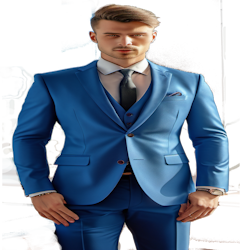
Key Characteristics
A single-breasted suit is defined by its jacket, which features a single row of buttons and a narrow overlap of fabric. Typically, these suits come with one, two, or three buttons, though the two-button variety is the most common. The design aims for a streamlined silhouette, making it a versatile option suitable for almost any occasion.
Advantages of Single-Breasted Suits
Versatility
The single-breasted suit shines in its versatility. It is appropriate for various settings, from casual to semi-formal and formal events. Its simple design makes it easy to pair with different shirts, ties, and accessories, allowing for multiple outfit combinations.
Flattering Fit
The single-breasted design is known for its ability to elongate the figure, making it a flattering choice for men of different body types. Whether you’re slim, average, or have a fuller figure, the single-breasted suit creates an illusion of height and slenderness.
Cost-Effectiveness
In general, single-breasted suits are less expensive than their double-breasted counterparts. Their simpler construction and lower fabric requirement make them more accessible for those on a budget, without sacrificing style.
Styling Tips
When it comes to styling a single-breasted suit, less is often more. A crisp white shirt and a silk tie in a complementary color are classic choices. However, don’t shy away from experimenting with patterned shirts or unique accessories to make a statement. Footwear can range from traditional leather Oxfords to more casual loafers, depending on the occasion.
The single-breasted suit remains a cornerstone in men’s fashion due to its classic appeal, adaptability, and flattering fit. Whether you’re new to suiting or looking to diversify your wardrobe, this type of suit offers an array of benefits that make it a wise investment for any gentleman.
- One-Button Suit: Typically seen in more casual or fashion-forward settings; often chosen for evening events.
- Two-Button Suit: The most versatile and commonly worn style, ideal for almost all body types.
- Three-Button Suit: Traditionally more formal and better suited for taller men.
The Distinctive Allure of Double-Breasted Suits
In the realm of men’s fashion, double-breasted suits occupy a special space signifying sophistication, tradition, and a flair for the dramatic. Often considered the more formal counterpart to the single-breasted suit, the double-breasted version has its roots in naval and military attire.
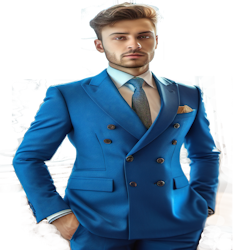
Key Features
Double-breasted suits are characterized by a jacket with two parallel rows of buttons, typically featuring six buttons in a 4-2 or 6-2 configuration, although other variants exist. The wider lapel and additional fabric that folds over create a more robust visual presence, adding layers to the outfit’s depth and formality.
Advantages of Double-Breasted Suits
Sophistication and Elegance
One of the most compelling aspects of a double-breasted suit is its inherent sophistication. The extra layer of fabric and the intricate button arrangement impart a level of formality that’s hard to match.
Enhanced Visual Appeal
The broad lapels and double rows of buttons add visual width to the upper body, making it an excellent choice for men with a slimmer build who wish to add some bulk to their silhouette. Conversely, it can provide a powerful, commanding look for those with a fuller frame.
Uniqueness
Double-breasted suits are less common than their single-breasted counterparts, which means wearing one makes a statement about your willingness to stand out and be daring in your fashion choices.
Styling Tips
Styling a double-breasted suit requires attention to detail. Due to its inherent formality, pairing it with a high-quality dress shirt and a conservative tie is often recommended. However, fashion-forward men are increasingly wearing these suits with turtlenecks or even high-quality crew-neck T-shirts for a modern twist. Footwear should lean towards the formal side—think leather Oxfords or polished loafers.
While double-breasted suits may not be for everyone, they offer a distinctive style and a heightened level of elegance. Whether you’re attending a high-stakes business meeting or a ritzy social event, the double-breasted suit can elevate your appearance, making you not just well-dressed but exceptionally so.
- Four-Button: Less traditional but easier to wear for various body types.
- Six-Button: The most classic double-breasted suit with two rows of buttons; it creates a broad-shouldered look.
The Allure of Specialty Suits: When Standard Just Won’t Do
In a world where standard black and gray suits dominate the formalwear scene, specialty suits offer a breath of fresh air.
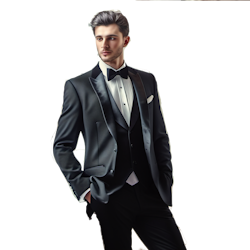
Here’s an exploration of specialty suits, from their defining features to the occasions that call for such sartorial splendor.
Defining Features
Specialty suits differ from their traditional counterparts in several ways. They may feature unconventional fabrics like velvet, seersucker, or even technical materials for particular professional needs. Patterns and colors are also less restricted, with options ranging from vibrant plaids to exotic animal prints. Moreover, these suits often feature unique cuts and decorative elements like piping, embroidery, or special pocket designs.
Occasions & Professions
Themed Events
From Great Gatsby parties to black-tie galas with specific color themes, specialty suits allow you to immerse yourself fully in the experience without compromising on elegance. For instance, a white dinner jacket might be the suit of choice for a summer soirée, while a tartan ensemble could make you the star of a Scottish-themed event.
Professional Needs
Certain professions require specialized suits that cater to unique work conditions. For instance, entertainers often wear suits made of breathable, stretchy materials that allow for ease of movement while performing. Aviation and automotive industries also have suits designed for both style and functionality, including flame-retardant properties.
Personal Style
If you’re a person who prides themselves on standing out from the crowd, specialty suits offer a way to express individuality. Whether you opt for a bold pattern or a unique color, these suits say that you’re not afraid to be different.
Specialty suits cater to the individual who seeks more than just the standard formal attire. They open up a world of possibilities for unique expression, professional requirements, or extraordinary occasions. While they may not replace your classic black or gray suit, they certainly add an exciting dimension to your wardrobe, ensuring you’re prepared for anything that comes your way.
- Tuxedo: Used for formal, black-tie events; often comes with satin lapels.
- Morning Suit: For ultra-formal daytime events; includes a long tailcoat, trousers, and often a waistcoat.
- Zoot Suit: Characterized by a longer jacket and wide-legged, high-waisted trousers; more of a vintage, cultural style.
The Three Titans of Suit Styles: British, Italian, and American
When it comes to men’s suiting, three distinct styles have dominated the scene: British, Italian, and American. Each one has unique features, and they cater to different preferences for fit, formality, and function. Understanding these styles can be instrumental in making an informed choice the next time you’re in the market for a suit.
British Style
Originating from the birthplace of the bespoke tailoring industry—Savile Row—British suits embody craftsmanship and attention to detail. They are generally characterized by structured shoulders, a suppressed waist, and a tailored fit, giving a sense of formality and elegance. British suits often feature double vents at the back, facilitating movement while preserving the suit’s shape. These suits are also well-known for their use of plaids, stripes, and traditional patterns. Ideal for formal and professional settings, British suits are a statement in classic luxury.
 Italian Style
Italian Style
If the British style leans towards formality, the Italian style embraces flair and comfort. Originating from fashion capitals like Milan, Italian suits are made to turn heads. They feature softer shoulders, lighter fabrics, and are often unlined for comfort. A hallmark of Italian suiting is the high gorge lapel, which provides a modern and stylish silhouette. The Italian style typically utilizes a single vent or no vent, allowing for a closer fit to the body. This suit is perfect for those looking to project confidence and sophistication in a more relaxed yet chic manner.
 American Style
American Style
The American style of suiting is rooted in practicality and comfort. Also known as the “sack suit,” the American suit offers a looser fit compared to its British and Italian counterparts. Characterized by natural shoulders and a straight-cut jacket, it provides ease of movement and is less restrictive. The American suit typically features a single vent at the back and minimal padding, making it ideal for casual and semi-formal occasions. Though often criticized for lacking the flair of Italian or the formality of British styles, the American suit is an adaptable and comfortable option.
Whether you prefer the traditional elegance of British tailoring, the stylish flair of Italian designs, or the comfort-driven American approach, understanding these three predominant styles can guide you in choosing a suit that best matches your needs and personality.
Understanding Suit Fabrics
The fabric significantly influences a suit’s appearance, comfort, and durability. Here are some popular options:
- Wool: Versatile, breathable, and available in various weights.
- Cotton: Less formal but breathable and comfortable.
- Linen: Ideal for hot weather but wrinkles easily.
- Cashmere: Luxurious and soft but less durable and more expensive.
The Fabric of Elegance: A Comprehensive Guide to Suit Fabrics
When it comes to men’s suits, the choice of fabric can be just as critical as the cut and style. The fabric you select not only impacts how the suit drapes and fits but also its longevity, comfort, and the occasions where it can be appropriately worn. Here’s a rundown on some of the most popular suit fabrics to help you make a more informed choice.
Wool
Wool is the gold standard for suit fabrics and comes in various types, including worsted, flannel, and tweed. Worsted wool is tightly woven and smooth, making it appropriate for all seasons. Flannel wool is softer and warmer, suitable for colder months. Tweed is a heavy, textured wool, ideal for outdoor use in winter.
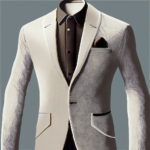
Pros:
- Breathable
- Durable
- Versatile
Cons:
- Can be expensive
- Heavier wools may be unsuitable for hot weather
Cotton
Cotton suits are lighter and less formal than wool suits, making them a good choice for casual wear or hot climates. They are breathable and provide a level of comfort that is hard to match.
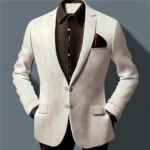
Pros:
- Breathable
- Relatively inexpensive
- Good for summer
Cons:
- Wrinkles easily
- Less formal
Linen
Linen suits are the epitome of casual elegance, especially popular in tropical climates and during the summer months. They are breathable and comfortable but wrinkle very easily.
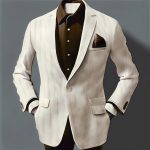
Pros:
- Extremely breathable
- Lightweight
- Ideal for hot climates
Cons:
- Wrinkles easily
- Not suitable for formal occasions
Silk
Silk suits are luxurious and comfortable, offering a natural sheen that stands out. They are breathable and perfect for both hot and cold climates but come at a premium price.
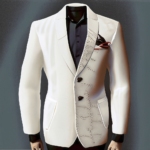
Pros:
- Luxurious feel
- Adaptable to temperature
- Unique sheen
Cons:
- Expensive
- Requires specialized care
Blends
In recent years, blended fabrics have gained popularity, combining the benefits of multiple materials. The most common blends are wool-polyester and wool-silk. They aim to enhance the durability, comfort, and cost-effectiveness of the suit.
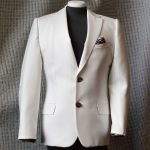
Pros:
- Versatile
- Often more affordable
- Can be custom-tailored to specific needs
Cons:
- May sacrifice the unique benefits of each fabric
- Quality varies significantly
Cashmere
Although a type of wool, cashmere deserves its own mention for its sheer luxury. It’s softer than traditional wool and provides a natural sheen. However, it’s less durable and much more expensive.
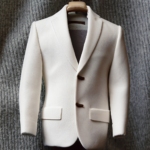
Pros:
- Extremely soft
- Luxurious look and feel
- Warm
Cons:
- Expensive
- Less durable than other wools
When choosing a suit, the fabric is not a place to cut corners. Consider the occasion, the climate, and how often you’ll be wearing the suit. Wool is a solid choice for all-around use, while cotton and linen are excellent for casual, hot-weather occasions. Silk and cashmere offer luxury at a price, and blends provide versatility.
By understanding the pros and cons of each fabric type, you can choose a suit that not only looks great but also serves its purpose admirably.
Suit Lapel Styles: The Subtle Art of Detailing
When it comes to men’s suits, the devil is often in the details. One such crucial detail that significantly impacts the overall aesthetic and formality of a suit is the lapel style. While it might seem like a minor aspect, the lapel can make or break the look you’re aiming for. Let’s take a closer look at the primary types of lapels and how they each contribute to the overall appearance of a suit.
Notch Lapel
The notch lapel is the most common lapel style you’ll encounter, characterized by a notch where the collar meets the lapel. It’s a versatile choice, apt for various occasions, including business meetings, weddings, and casual events. The notch lapel lends itself well to single-breasted jackets and is generally considered the safest, most adaptable choice.
 Pros:
Pros:
- Versatile
- Suitable for almost all occasions
- Classic and timeless
Cons:
- May be viewed as ‘too safe’ for those looking to make a fashion statement
Peak Lapel
The peak lapel is more formal than the notch and is defined by lapel edges pointing upwards, towards the shoulder. This style is traditionally seen on double-breasted suits and tuxedos, though modern fashion has made it acceptable on single-breasted suits as well. The peak lapel adds a touch of flair and is best suited for formal events.
 Pros:
Pros:
- Formal and elegant
- Draws attention upward, elongating the frame
- Makes a statement
Cons:
- Not as versatile for casual settings
- Can seem overly dramatic if not worn correctly
Shawl Lapel
The shawl lapel is a rounded, uninterrupted curve that usually features on tuxedo jackets and dinner suits. The absence of notches or peaks offers a cleaner, more streamlined look. This style is inherently formal and best suited for black-tie events.
 Pros:
Pros:
- Smooth, elegant aesthetic
- Ideal for formal, black-tie events
- Simplifies the outfit, placing emphasis on the overall look
Cons:
- Limited in versatility
- Not appropriate for business or casual settings
The lapel style you choose should align with the occasion, your body type, and the overall look you aim to achieve. The notch lapel offers the most flexibility, the peak lapel exudes a sense of formality and drama, while the shawl lapel is reserved for the most formal affairs.
Whichever you pick, ensure it complements the rest of your attire, including the fit of your suit, choice of fabric, and accessories. The right lapel can subtly enhance your outfit, showcasing not just your suit but also your understanding of nuanced sartorial choices.
Suit Buttons: A Subtle Art of Style and Function
In the grand scheme of men’s fashion, buttons on a suit may seem like a minor detail, but they hold significant influence over the overall look, style, and functionality of the outfit. From the type and number of buttons on a jacket to the buttons on the trousers and sleeves, these seemingly small elements can drastically change how a suit appears and feels. This article aims to delve into the different styles and uses of suit buttons.
Number of Buttons
Single-Button
A single-button suit jacket is often associated with tuxedos and is considered the most formal option. The lack of additional buttons creates a clean, sleek look that draws attention to the natural waistline, making it flattering for most body types.
Two-Button
The two-button suit is the most versatile and widely used style. It’s a classic choice that offers a slimming effect by elongating the torso, making it a good fit for most occasions, whether formal or casual.
Three-Button
Three-button suits are traditional and conservative, often associated with British tailoring. These suits are ideal for taller individuals as the buttons are spaced higher, creating a balanced look.
Double-Breasted
While not as common as single-breasted suits, double-breasted jackets often feature four, six, or even eight buttons. This style has a European flair and offers a sense of sophistication but is generally best for those with slim or athletic builds.
Types of Buttons
Standard Plastic Buttons
These are the most common and cost-effective. They do the job but might not add much in terms of style or durability.
Horn Buttons
Horn Buttons: Offer a natural and classic appearance.
Derived from buffalo or cow horn, these buttons are durable and add a touch of natural texture and color variance to a suit.
Mother-of-Pearl Buttons
Mother-of-Pearl Buttons: Lustrous and elegant, often found on high-end suits.
Usually found on high-end suits, these buttons have a unique sheen and are incredibly durable but can be expensive.
Metal Buttons
Metal Buttons: Usually gold or silver, they add a touch of formality and are commonly found on blazers.
Used in blazers and nautical-themed suits, metal buttons often feature intricate designs or symbols, adding a distinctive touch to the outfit.
Functional Sleeve Buttons
Also known as “surgeon’s cuffs,” these functional buttons can be unbuttoned, originally designed for surgeons to roll up their sleeves easily. Today, they are a mark of a well-crafted, high-end suit.
Functional Cuff Buttons: Also known as “surgeon’s cuffs,” they can be unbuttoned, signaling custom tailoring.
Considerations
While it may be tempting to go for unique or flashy buttons, remember that subtlety is key. You want the buttons to complement, not overshadow, the suit. Consider your body type and the occasions for which you’ll be wearing the suit when deciding on the number and type of buttons.
Buttons may be a small part of a suit, but they hold immense influence over style and functionality. By taking the time to understand and choose the right buttons for your suit, you are paying homage to the subtleties that make menswear a true art form.
The Craft Behind the Look: Understanding Suit Stitching Styles
When you’re investing in a quality suit, you’re not just paying for the fabric or the brand name. The stitching style plays a significant role in how the suit will wear over time, how it conforms to your body, and ultimately, how it looks on you. Understanding the different types of stitching methods can help you make an informed choice when you’re shopping for your next suit. Here are some popular stitching styles and techniques used in suit construction.
Full-Canvas Construction
Full-canvas suits are the pinnacle of suit-making. In this style, a canvas made of horsehair or a similar material is stitched between the suit fabric and the lining. This gives the suit its structure and shape, allowing it to mold to the wearer’s body over time. The canvas also distributes tension across the fabric, reducing stress on the seams and enhancing durability.
Pros:
- Highest level of craftsmanship
- Molds to the wearer’s body
- Long-lasting
Cons:
- Expensive
- Heavier
Half-Canvas Construction
The half-canvas suit offers a middle-ground solution, featuring a canvas in the chest and lapel area while relying on fusible interfacing in the lower parts of the jacket. This provides a good balance of structure and comfort, making it lighter than the full-canvas but still offering a decent drape.
Pros:
- More affordable than full-canvas
- Good balance of structure and flexibility
Cons:
- Less durable than full-canvas
- May not conform as well to the body
Fused Construction
In a fused suit, a heat-sensitive adhesive is used to glue the suit fabric to its lining. This is the most cost-effective method, and you’ll often find fused suits at lower price points. However, fused suits are less breathable and are prone to bubbling and deforming over time, especially after dry cleaning.
Pros:
- Most affordable
- Quick to manufacture
Cons:
- Prone to wear and tear
- Less breathable
Pick Stitching
This is a decorative stitching style usually found on the lapels and pockets. Pick stitching was traditionally a sign of a handmade suit, though it’s now also done by machine. It adds a subtle but luxurious touch to a suit’s appearance.
Pick Stitching: Visible stitches along the lapel and pockets for a handmade appearance.
Surgeon’s Cuffs
High-quality suits often feature “surgeon’s cuffs,” functional buttons on the sleeve that can actually be unbuttoned. This was originally a feature in military suiting and has become a hallmark of quality craftsmanship.
The stitching style significantly influences the durability, comfort, and appearance of a suit. Full-canvas suits offer the highest quality but come at a premium price. Half-canvas suits provide a middle-ground alternative, balancing cost and quality. Fused suits are best for those on a budget but compromise on longevity and comfort. Details like pick stitching and surgeon’s cuffs can elevate your suit’s overall aesthetic and showcase quality. Understanding these styles will guide you in making an investment that aligns with both your budget and your sartorial standards.
The Anatomy of Elegance: A Guide to Suit Pocket Types
In the world of men’s fashion, the suit reigns supreme as a staple of elegance and sophistication. While the cut, fabric, and style of a suit are often the main focus, the devil is indeed in the details. One such detail that tends to be overlooked is the type of pockets a suit has. The choice of pocket can influence not just the suit’s functionality but also its overall aesthetic appeal. Let’s explore the common types of suit pockets and how they contribute to a suit’s form and function.
Patch Pockets
A patch pocket is the most informal type of pocket, made by stitching a separate piece of fabric onto the outside of the jacket. Commonly found on sports jackets and casual suits, patch pockets add bulk to the suit, which can help balance out slender figures.
Patch Pockets: A casual option that adds a bit of texture and depth.
Pros:
- Casual, relaxed look
- Easy to access
Cons:
- Less formal
- Adds bulk, which might not be suitable for all body types
Jetted Pockets
Jetted pockets are the most formal type of pocket, offering a sleek and streamlined look. They consist of a thin slit in the fabric, finished with welting for a refined appearance. Jetted pockets are often found on tuxedos and other formal suits where a minimalist aesthetic is desired.
Jetted Pockets: Most formal, found on tuxedos and formal suits.
Pros:
- Sleek and formal
- Minimalist design
Cons:
- Limited storage
- Difficult to access
Flap Pockets
Perhaps the most versatile type of pocket, flap pockets are found on a wide range of suits from business to casual. These are essentially jetted pockets with an additional flap of fabric that covers the pocket’s opening. The flap adds a layer of formality without being overly stuffy, making it suitable for various settings.
Flap Pockets: Standard on most suits.
Pros:
- Versatile and widely used
- Offers a balanced look
Cons:
- The flap can sometimes curl with wear
- Not suitable for ultra-formal occasions
Ticket Pockets
A nod to traditional British tailoring, ticket pockets are smaller pockets positioned above the standard side pocket. Originally designed to hold train tickets, these pockets are now more of a style statement.
Pros:
- Adds a touch of vintage charm
- Additional storage
Cons:
- May clutter the suit’s lines
- Not commonly used; can appear outdated
Besom Pockets
Besom pockets are a variation of jetted pockets, featuring a fabric or satin trim around the pocket slit. They add a decorative touch without compromising the suit’s sleek profile.
Pros:
- Adds subtle detailing
- Streamlined design
Cons:
- Limited storage
- Less common, may not be readily available
Understanding the nuances of pocket types can significantly influence your suit’s formality level, aesthetic quality, and practicality. Whether it’s the casual charm of patch pockets or the formal grace of jetted pockets, the right choice can elevate your suit from standard to standout. Choose wisely, and let your pockets be more than just an afterthought.
The Fine Art of Lapel Detailing: A Guide to Contrast Lapel Buttonholes and Lapel Pins
When it comes to men’s suits, every detail matters. Though it may seem minor, lapel detailing can offer subtle touches that elevate your entire look. Two popular ways to accentuate your suit’s lapels are through a contrast lapel buttonhole and the use of lapel pins or boutonnieres. These seemingly small elements can impart both character and sophistication to your outfit.
Contrast Lapel Buttonhole
Traditionally, the lapel buttonhole was a functional feature, designed to allow the lapel to be buttoned to the opposite side, offering extra protection against the elements. In modern fashion, it’s more often a decorative element that can be customized for a unique look. One stylish way to do this is by choosing a contrasting thread color for the lapel buttonhole.
Contrast Lapel Buttonhole: A different color of thread can be used on the lapel buttonhole for subtle distinction.
A different color of thread can create a visual focal point, providing a subtle distinction that sets your suit apart. It’s an understated way to inject personality into your outfit without overwhelming the look. For example, a navy suit with a white lapel buttonhole creates a nautical flair, while a charcoal suit with a red buttonhole can provide a pop of color.
Lapel Pin or Boutonniere: Adds a decorative touch.
Pros:
- Adds individuality to a suit
- Offers a sophisticated touch
Cons:
- May not be suitable for ultra-formal events
- Must be chosen carefully to complement the suit’s color
Lapel Pin or Boutonniere
Adding a lapel pin or boutonniere is another way to personalize your suit. While lapel pins are usually made from metal and may represent organizations, causes, or interests, a boutonniere is a small floral decoration that adds a classic and elegant touch to your suit.
Lapel Pin or Boutonniere: Adds a decorative touch.
Lapel pins and boutonnieres are more than mere accessories; they can serve as conversation starters and express personal style or convictions. Whether you choose a simple, elegant flower for a wedding or a unique pin that represents a personal interest, these details make your ensemble distinctly yours.
Pros:
- Adds decorative flair
- Can serve as a conversation starter
Cons:
- Can clutter the suit if overdone
- Must be appropriate for the occasion
Whether you opt for a contrast lapel buttonhole or a unique lapel pin, these details can turn an ordinary suit into an extraordinary ensemble. So the next time you’re looking to upgrade your suit game, don’t underestimate the power of lapel detailing. Both functional and decorative, the right choices can make all the difference.
Elevate Your Suit Game: A Look into Fabric Details
Suits come in all shapes, sizes, and styles, but what truly sets a suit apart are the details—those small, often overlooked elements that showcase craftsmanship and personal taste. Two fabric details that can significantly elevate a suit’s aesthetic are a velvet collar and contrast lining. Each offers a unique way to inject style, personality, and flair into an outfit.
Velvet Collar
The velvet collar is a distinguished detail that instantly adds an air of sophistication and elegance.
Velvet Collar: Often seen on formal or vintage suits.
It is most commonly found on formal or vintage suits and is reminiscent of old-world charm. Traditionally, this feature originated from the smoking jackets worn by gentlemen in the 19th century, which were designed to absorb the smell of cigars.
Now, velvet collars often grace tuxedos and formal evening wear, providing a tactile contrast to the main fabric.
Pros:
- Adds a luxurious touch
- Elevates the suit to a formal setting
- Provides a rich contrast in texture
Cons:
- Can be perceived as too ostentatious for casual settings
- Requires special care and cleaning
Contrast Lining
The inside of a suit jacket is usually not visible, but adding contrast lining can make it a statement piece of its own. This detail offers a delightful surprise element when you unbutton your jacket or roll up your sleeves.
Contrast Lining: Adds a surprise element and is a way to inject personal style.
It’s an excellent way to express individuality and personal style without affecting the suit’s overall formality. Whether it’s a bold color, a pattern, or even a custom design, the choice is yours, and it makes the jacket uniquely yours.
Pros:
- Adds a hidden layer of personalization
- Makes the suit unique without compromising its external appearance
- Can be customized to reflect personal interests or colors
Cons:
- Not visible unless the jacket is open or sleeves are rolled up
- May not be suitable for ultra-conservative settings
Fabric details like a velvet collar and contrast lining provide unique opportunities to customize your suit and make it a true reflection of your personal style. They show attention to detail and appreciation for craftsmanship that goes beyond the standard options. So, the next time you’re in the market for a new suit or considering alterations, think about these fabric details—they could turn your good suit into a great one.
The Subtle Significance of Suit Vents: A Guide to Styles and Choices
In the realm of men’s suiting, even the smallest details can have a significant impact on comfort, style, and functionality. One such detail often overlooked is the style of suit vents, the slits located at the back of a jacket.
Though they may seem inconsequential, the type of vent you choose can drastically alter the overall look and feel of your suit. Here’s a guide to the three primary styles: the single vent, the double vent, and the ventless design.
Single Vent
The single vent is a solitary slit located at the center of the jacket’s back, commonly found on American-style suits. Originating from equestrian clothing, it offers more room for movement, making it practical for everyday wear.
Center Vent: A single vent at the back of the jacket.
Pros:
- Convenient and comfortable
- Easier on the pocket
- Versatile for various occasions
Cons:
- Less formal than other vent styles
- Can expose the backside when sitting
Double Vent
The double vent, often associated with British tailoring, features two slits, one on each side of the jacket’s back. This design not only allows for a more tailored fit but also grants increased mobility and maintains a refined look when you sit or move.
Pros:
- Highly versatile and modern
- Adds a touch of sophistication
- Allows easier access to trouser pockets
Cons:
- Generally more expensive due to the added tailoring involved
- May require more frequent adjustments to maintain the suit’s shape
Ventless
As the name suggests, ventless suits have no vents, providing a sleek and slim silhouette. This style is commonly found in Italian suits and is considered the most formal of the three options.
Pros:
- Offers a clean, streamlined look
- Ideal for formal occasions
Cons:
- Limited mobility
- May wrinkle or bunch up when sitting
While the vent style may seem like a minor consideration, it has a considerable impact on your suit’s aesthetic and function.
The single vent offers practicality, the double vent leans towards style and comfort, and the ventless option provides a formal, clean silhouette.
Understanding these differences will help you make an informed choice, ensuring that your suit not only looks impeccable but also aligns with your needs and lifestyle.
The Allure of Textural Details: Satin Stripes and Grosgrain in Formalwear
In the world of men’s fashion, especially when it comes to formalwear, the devil is in the details. While the silhouette, cut, and fabric often capture the most attention, subtler elements like textural details can make a significant difference. They offer a unique blend of sophistication and individuality without veering into ostentation. Two notable textural details in formal attire are satin stripes and grosgrain.
Satin Stripes
Commonly seen in the realm of black-tie events, satin stripes run along the outer seams of tuxedo trousers. They provide a polished aesthetic that separates tuxedo pants from standard suit trousers. The satin stripe offers a contrast in both color and texture, usually set against a darker, matte fabric. This serves to elongate the leg and elevate the overall look.
Pros:
- Adds visual interest to trousers
- Enhances the formal aesthetic
- Creates an elongating effect on the leg
Cons:
- Strictly for formal events, limiting versatility
- May clash with other textures if not coordinated well
Grosgrain
Grosgrain is a distinctive ribbed fabric often utilized on the lapels of tuxedos. Unlike the smooth finish of typical suit lapels, grosgrain offers a subtle textural contrast that enriches the garment’s appearance. It creates a tactile element that invites closer inspection, turning the lapel into a focal point of the ensemble.
Pros:
- Adds a layer of complexity to the tuxedo
- Provides a luxurious feel and appearance
- Ideal for special occasions where detail matters
Cons:
- Can appear overly formal for some events
- Needs proper care to maintain its look
Though they may seem minor, textural details like satin stripes and grosgrain can greatly elevate the aesthetic of formalwear. They serve to separate the mundane from the magnificent, showcasing the wearer’s attention to detail and appreciation for the finer things.
When it comes to occasions that require a heightened sense of style and formality, these textural elements can provide the defining touch that transforms a good outfit into a great one. Therefore, the next time you find yourself shopping for formal attire, don’t overlook these exquisite details; they might just be what you need to make a lasting impression.
Elevating Style with Cuff and Hem Details: The Power of Turn-ups on Trousers
In the world of men’s fashion, the small touches often make the most significant impact. When discussing suits and formalwear, much attention is given to the type of fabric, lapels, and even pocket styles. However, another detail deserving consideration is how the trousers finish at the bottom—specifically, the choice between a straight hem and turn-ups, also known as cuffs. This seemingly insignificant feature can dramatically affect both the appearance and feel of an outfit.
Turn-ups/Cuffs
Turn-ups or cuffs refer to a folded-up hem usually seen at the bottom of men’s trousers. The style dates back to the early 20th century and has undergone various periods of popularity. Cuffs add a bit of weight to the bottom of the trousers, making them hang more naturally and drape better. This additional weight provides the trousers with a more structured look, enhancing the overall formality of the outfit.
Pros:
- Adds weight, improving the drape of the trousers
- Enhances the formality of the ensemble
- Provides an opportunity for subtle styling, especially when combined with specific types of shoes or socks
Cons:
- May not be suitable for very casual or highly formal outfits
- Can visually shorten the leg, making it less ideal for those looking to elongate their appearance
- Requires extra fabric, which may add to the overall cost of the trousers
The Aesthetic Value
While the primary function of cuffs is practical, they also serve an aesthetic purpose. A well-executed cuff can balance the trousers with the rest of the outfit, especially if it includes heavier elements like a double-breasted jacket or textured fabrics. It’s a finishing touch that shows attentiveness to detail and a nuanced understanding of style.
The decision to add cuffs to your trousers might seem trivial, but as with any aspect of fashion, the details are where true style comes to life. They offer a chance to subtly express your personality and flair, injecting formality and weight into your trousers.
Whether you’re looking to impress at a business meeting or a social event, don’t underestimate the impact of this classic detail. In the world of sartorial elegance, the devil is, indeed, in the details.
The Importance of Fit: Making or Breaking Your Suit Game
In the realm of men’s fashion, particularly in the world of suits, one truth reigns supreme: fit is king. No matter the quality of the fabric, the uniqueness of the design, or even the prestige of the brand, a suit will never reach its full potential if it doesn’t fit well. A poor fit can be a sartorial disaster, reducing even the most expensive suit to mere mediocrity. In contrast, a well-fitting suit can elevate your appearance, make you feel more confident, and leave a lasting impression. So, how does one achieve that perfect fit? Here are the key areas to focus on.
Shoulders: The Starting Point
The shoulders are the architectural base of any suit. They set the stage for how the rest of the garment will fall on your body. A well-fitted shoulder seam should end exactly where your shoulders do, ensuring a natural and unforced look. If the seam is too far in, the jacket will pull and appear tight; too far out, and it will make you look bulky or disheveled.
Pros:
- Creates a natural, tailored silhouette
- Serves as the foundation for the rest of the suit
Cons:
- Incorrect sizing can lead to uncomfortable tightness or unflattering bulkiness
- One of the hardest areas to alter, so it’s crucial to get it right initially
Chest: Room for Comfort
The chest area should allow for comfortable movement, without looking baggy. You should be able to easily button the jacket without it straining across the chest. The fabric should lie flat, allowing for a smooth line from the lapel down to the button. This balance between comfort and aesthetics is vital; a straining button is a surefire sign of a poor fit, while excess material will make the jacket look oversized and sloppy.
Pros:
- Allows for optimal comfort and mobility
- A well-fitted chest enhances the overall proportion of the suit
Cons:
- A tight fit can lead to premature wear and tear
- Excess room can disrupt the suit’s visual harmony
Trousers: Striking the Balance
Trousers are often the most neglected part of a suit, but they play a critical role in complementing the overall look. They should sit comfortably at your waist without the need for a belt to hold them up. The break—the point where the trouser meets the shoe—should be slight, avoiding both a pile-up of fabric at the bottom and an awkwardly high cut that exposes too much sock.
Pros:
- A slight break complements most body types
- Well-fitted trousers offer comfort without sacrificing style
Cons:
- Incorrect length can ruin an otherwise impeccable suit
- Too tight or too loose trousers can create an imbalanced look
When it comes to suiting, the importance of a perfect fit cannot be overstated. Even the most exquisitely crafted, high-end suit can look mediocre if it doesn’t fit properly. The shoulders, chest, and trousers are the key areas to get right, each contributing to the comfort and visual appeal of the outfit.
Investing time and effort into understanding these critical points of measurement will pay off exponentially. Whether you’re going off-the-rack or opting for bespoke tailoring, attention to fit is your surest route to sartorial excellence. A well-fitted suit doesn’t just enhance your appearance; it elevates your entire presence, making you look and feel like the best version of yourself.
The Art of Customization: Personalizing Your Perfect Suit
When it comes to suiting, one size doesn’t fit all. Customization is the pinnacle of personal style, an opportunity to take a standard garment and transform it into something that is uniquely yours. Opting for a custom suit opens up an array of choices, allowing you to put your signature on various aspects like lapels, buttons, vents, and pockets. Let’s delve into these elements and discuss how each can be personalized to reflect your taste and lifestyle.
Lapels: Setting the Tone
The lapel is one of the most eye-catching parts of your suit jacket and can significantly influence the overall style. Typically, you’ll have three options to choose from:
Notch Lapels
- Best For: Versatility, everyday business wear
- Visual Appeal: Classic and understated
- Personalization: Width and buttonhole detailing
Peak Lapels
- Best For: Formal events, double-breasted suits
- Visual Appeal: Bold and powerful
- Personalization: Width and the angle of the peak
Shawl Lapels
- Best For: Black-tie events, tuxedos
- Visual Appeal: Smooth and elegant
- Personalization: Width and curve radius
Buttons: More Than Just Functionality
When it comes to buttons, the number and style can influence both the aesthetic and functionality of the suit. Single-breasted jackets commonly have one or two buttons, while double-breasted options offer four or more. Button materials can range from standard plastic to luxe mother-of-pearl, offering you an extra layer of customization.
Pros:
- Choice of material can elevate the suit’s look
- Button stance can affect the elongation of your torso
Cons:
- Over-customization can make the suit less versatile
Vents: Comfort and Style
Vents are slits at the back of your suit jacket, designed for both comfort and style. The two primary options are:
Single Vent
- Best For: Slimmer builds, less formal settings
- Personalization: Vent length and width
Double Vents
- Best For: Greater ease of movement, formal wear
- Personalization: Vent length and positioning
Pockets: The Essential Detail
Pockets may seem minor but can drastically change the formality and functionality of your suit.
Patch Pockets
- Best For: Casual settings, summer suits
- Personalization: Pocket size and curve
Flap Pockets
- Best For: Business settings, versatility
- Personalization: Flap width and angle
Jetted Pockets
- Best For: Formal events, sleek aesthetic
- Personalization: Width and depth of the pocket slit
Customizing a suit is an art form that blends personal taste with timeless style. The customization options are not mere adornments but crucial elements that define the suit’s personality and functionality.
By selecting the right lapel style, button configuration, vent type, and pocket design, you create a garment that is as individual as you are. So the next time you opt for a custom suit, make full use of these options to craft something that speaks to your unique style and needs.
After all, in a world full of off-the-rack options, a custom suit is your ticket to standing out in the best way possible.
Understanding the Pricing of Custom Men’s Suits: A Comprehensive Guide
When it comes to purchasing a custom men’s suit, the old adage “You get what you pay for” holds true. With a plethora of options on offer, the pricing can vary significantly based on a myriad of factors including the tailor’s reputation, the quality of fabric, and the level of customization involved. Here’s a general guideline to navigate the sometimes complex landscape of custom suit pricing.
Entry-Level Custom Suits
Price Range: $600 – $1,200
Opting for an entry-level custom suit often involves taking an off-the-rack suit and having it adjusted to fit your measurements. The options for fabric and customization will typically be limited.
Features
- Adjusted to fit
- Limited fabric choices
- Basic customization
- Price Range: $600 – $1,200
- Features: Off-the-rack suit that is adjusted to fit, limited fabric and customization options.
- Typical Lead Time: 1-3 weeks
Typical Lead Time: 1-3 weeks
Pros:
- Quick turnaround
- Budget-friendly
- Suitable for those new to custom suits
Cons:
- Limited uniqueness
- May lack the finesse of higher-end suits
Mid-Range Custom Suits
Price Range: $1,200 – $2,500
In this category, you’ll find more fabric choices and often half-canvas construction, which provides a decent balance of durability and comfort.
Features
- Greater fabric variety
- Half-canvas construction
- Moderate customization options
- Price Range: $1,200 – $2,500
- Features: More fabric choices, often half-canvas construction, moderate customization options.
- Typical Lead Time: 4-7 weeks
Typical Lead Time: 4-7 weeks
Pros:
- Higher quality than entry-level
- Better fit and more customization
- Wider selection of fabrics
Cons:
- Longer wait time
- Higher cost
High-End Custom Suits
Price Range: $2,500 – $5,000+
For those who are willing to splurge, high-end custom suits offer exclusive fabrics, fully-canvassed construction, extensive customization, and hand-stitched details.
Features
- Exclusive fabrics
- Fully-canvassed
- Extensive customization
- Hand-stitched details
- Price Range: $2,500 – $5,000+
- Features: Exclusive fabrics, fully-canvassed, extensive customization, hand-stitched details.
- Typical Lead Time: 8-12 weeks or more
Typical Lead Time: 8-12 weeks or more
Pros:
- Superior quality and craftsmanship
- Highly personalized
- Ideal for special occasions or high-profile events
Cons:
- Expensive
- Longer lead time
Luxury or Designer Custom Suits
Price Range: $5,000 – $20,000 and above
At the top of the pyramid are ultra-luxurious, bespoke suits often crafted under the supervision of a master tailor.
Features
- Ultra-luxurious fabrics
- Bespoke tailoring
- Exhaustive customization
- Price Range: $5,000 – $20,000 and above
- Features: Ultra-luxurious fabrics, bespoke tailoring, exhaustive customization, often made by or under the supervision of a master tailor.
- Typical Lead Time: Several months
Typical Lead Time: Several months
Pros:
- Ultimate expression of personal style
- Exquisite craftsmanship
- Heirloom quality
Cons:
- Prohibitively expensive for most
- Extremely long lead time
Additional Costs
- Fittings: May be included or could be extra, depending on the tailor.
- Alterations: Changes after completion could add to the cost.
- Embellishments: Unique buttons, contrast stitching, and special linings could also inflate the final price.
The pricing of custom men’s suits can be complex but understanding what you’re paying for at each level can help you make an informed decision that balances both your budget and your sartorial expectations.
Regardless of what you choose, remember that a well-fitted suit is an investment in yourself—one that pays dividends in confidence and style.
Navigating the Terrain of Custom Suits with Heavy Beading and Appliqués: A Guide on Estimated Costs and Time
In the world of custom suiting, adding special elements like heavy beading or appliqués can transform a basic suit into a statement piece.
However, such detailed embellishments bring with them additional costs and time commitments.
This guide will provide you with rough estimates for materials, labor, fittings, and extra embellishments to help you navigate this specialty terrain.
Materials
Fabric
The cost of fabric can range from $40 to $200 per yard depending on its quality and rarity.
For a standard two-piece suit, you might require between 3-5 yards. Therefore, you could be looking at anywhere from $120 to $1,000 just for the fabric.
- Fabric: $40 – $200 per yard, depending on the quality and rarity.
- You might need 3-5 yards for a suit.
- Beads and Appliqués: $50 – $500+ depending on quality and quantity.
Beads and Appliqués
The price of beads and appliqués can vary significantly.
High-quality or unique elements could range from $50 to $500 or even more depending on the intricacy and materials involved.
- Beadwork and Appliqués: Expect $15 – $50 per hour for specialized handwork, which could take 10 to 40 hours depending on complexity.
Labor
Basic Suit Construction
The basic construction of a custom suit typically runs from $1,000 to $3,000, which includes the skilled labor of cutting, sewing, and fitting the garment.
- Basic Suit Construction: $1,000 – $3,000 for skilled labor.
Specialized Handwork
For handwork such as beadwork or applying appliqués, you can expect to pay between $15 to $50 per hour.
Depending on the complexity of the design, this could take between 10 to 40 hours, thus adding $150 to $2,000 to your total cost.
Fittings
Initial and Intermediate Fittings
Most tailors include the cost of initial and intermediate fittings in the labor charges. However, if your design demands numerous fittings, some tailors might charge an additional $100 to $200 per session.
Extra Embellishments
Additional details like unique buttons, linings, or specialty stitching could cost between $50 and $200, and even more if you opt for rare or exclusive materials.
- Initial and Intermediate Fittings: Generally included in labor costs, but some tailors may charge $100 – $200 extra per session if numerous fittings are required.
- Buttons, Linings, Stitching, etc.: $50 – $200, but can go much higher for exclusive or rare materials.
Time Estimates
Basic Suit
The lead time for a standard custom suit is usually between 4 to 8 weeks.
- Basic Suit: 4 – 8 weeks
- With Beadwork and Appliqués: Add an extra 2 – 4 weeks, or even longer depending on complexity and the availability of the tailor.
Specialized Suits
Adding beadwork or appliqués can extend this timeline by an additional 2 to 4 weeks, or even longer depending on the tailor’s availability and the complexity of the work.
Total Estimated Costs
- Mid-Range: $2,000 – $4,000
- High-End: $4,000 – $7,000
- Luxury: $7,000 and up
Overall Estimated Costs and Time
Mid-Range
For a moderately embellished suit, expect total costs to fall in the range of $2,000 to $4,000. The estimated time for completion would be between 6 to 12 weeks.
High-End
For a high-end custom suit with extensive embellishments, total costs could range from $4,000 to $7,000, with an estimated completion time of 6 to 12 weeks.
Luxury or Specialized
For the ultimate in custom tailoring with extravagant embellishments, expect to pay upwards of $7,000, with a timeline stretching from 12 weeks to several months.
It’s crucial to note that these are only rough estimates, and the true cost and time required can fluctuate depending on various factors. Therefore, the most reliable way to get accurate figures is by consulting with a tailor skilled in custom work with heavy beading and appliqués. Investing in such a specialized garment not only requires financial commitment but also time, yet the result is a truly unique piece that reflects your individual style and taste.
Total Estimated Time
- Mid-Range and High-End: 6 – 12 weeks
- Luxury or Specialized: 12 weeks to several months
A Detailed Cost and Time Breakdown for Custom Suits with Embellishments
When it comes to creating a custom suit that includes special features like heavy beading or appliqués, the total investment includes several different components: materials, labor, fittings, and any extra embellishments you might desire. Here’s a comprehensive cost and time breakdown to guide you through this intricate process, keeping in mind that these are rough estimates.
Cost Breakdown
Materials
- Fabric: A yard of fabric can cost anywhere between $40 and $200. Typically, you’ll need about 3-5 yards for a suit, so you’re looking at a range of $120 to $1,000 for fabric alone.
- Beads and Appliqués: The cost of these embellishments can vary widely, ranging from $50 to $500, depending on the quality and intricacy.
Labor
- Basic Suit Construction: The labor costs for constructing a basic custom suit can range from $1,000 to $3,000 depending on the tailor’s expertise and location.
- Beadwork and Appliqués: Specialized labor like beadwork can cost you $15 to $50 per hour, and may require 10 to 40 hours, depending on the complexity. This adds another $150 to $2,000 to your total.
Fittings
- Initial and Intermediate Fittings: Some tailors include the cost of initial and intermediate fittings within the labor cost. If not, they may charge $100 to $200 extra for these sessions.
Extra Embellishments
- Buttons, Special Linings, Stitching, etc.: Unique buttons, linings, or specialized stitching can cost an additional $50 to $200, depending on the material and labor involved.
Total Estimated Costs
- Mid-Range: You might spend anywhere between $1,370 to $4,900 for a mid-range custom suit with moderate embellishments.
- High-End: For a more exclusive experience, you could spend between $4,900 and $7,700.
- Luxury: If you opt for the most luxurious fabrics and extensive customization, the costs could start at $7,700 and go much higher.
Time Breakdown
Basic Suit Construction
- Construction: The basic construction of a custom suit generally takes 4 to 8 weeks.
Additional Time for Embellishments
- Complex Embellishments: Beadwork and appliqués can add 2 to 4 additional weeks to the timeline.
Fittings
- First Fitting: Usually happens after 2-3 weeks of initial work.
- Intermediate Fittings: These are as needed and often occur around the midpoint of construction.
- Final Fitting: Typically, you’ll have a final fitting a week or two before the suit is completed.
Total Estimated Time
- Mid-Range and High-End: 6 to 12 weeks
- Luxury or Specialized: 12 weeks to several months
It’s crucial to understand that these are generalized estimates, and the actual costs and timelines can vary.
To get the most accurate pricing and time frame, it’s recommended to consult with a skilled tailor who can provide a detailed quote tailored to your specific needs and preferences.
Whether you’re opting for a mid-range suit or a luxury experience, this breakdown will give you a clearer idea of what to expect in terms of cost and time.
A Comprehensive Guide to Typical Suit Fabrics
In the world of tailored suits, the fabric plays a pivotal role in determining not just the aesthetic appeal but also the comfort and durability of the suit. The fabric can also affect how appropriate your suit is for specific occasions or climates. Here is an overview of typical suit fabrics, their characteristics, and their best uses.
Wool
Wool is the most popular and versatile fabric for suits. Known for its comfort and resilience, wool suits are perfect for all sorts of occasions and climates. They come in different weights and textures, which means you can find a wool suit for both a winter wedding and a summer office day. Wool also has natural breathability and moisture-wicking properties.
Types of Wool
- Tropical Wool: This is a lightweight wool that is breathable and particularly well-suited for warmer climates.
- Worsted Wool: It’s a medium-weight wool fabric that has a smooth texture. Worsted wool is perhaps the most common type and is versatile enough to be worn in all seasons.
Cotton
Cotton is generally less formal than wool and isn’t as breathable. However, cotton suits are an excellent choice for casual occasions or summer outings. They are typically lighter and lend themselves well to lighter colors, which can be particularly appealing in the summer months.
Linen
Linen suits are ideal for hot, tropical climates. The fabric is incredibly breathable but has one significant downside—it wrinkles easily. As such, linen suits are mostly reserved for summer and casual wear. They might not be the best choice for a formal business setting but are perfect for beach weddings or summer parties.
Cashmere
Cashmere suits are the epitome of luxury. The fabric is incredibly soft and comfortable but is less durable than wool and considerably more expensive. Because of its cost and delicacy, cashmere is often blended with wool to combine the comfort of cashmere with the durability of wool.
Silk
Silk is another luxurious option for suits. Known for its natural sheen, silk suits are incredibly comfortable and breathable. However, like cashmere, silk is less durable and more costly. It’s a fabric often reserved for special occasions due to its unique luster and premium feel.
Polyester/Rayon
These synthetic fabrics are generally less expensive than their natural counterparts, but they lack breathability and comfort. Polyester and rayon suits might be suitable for those on a budget, but they are generally not recommended for a high-quality suit. These materials can also give off an unnatural sheen, which can cheapen the overall look of the suit.
Blends
Blended fabrics are created by combining different types of fibers. The aim is often to optimize the benefits of each fabric. For example, a wool-cashmere blend may offer the durability of wool with the softness of cashmere. Similarly, a wool-polyester blend might be more cost-effective than pure wool while still offering some of wool’s natural benefits.
Choosing the right fabric is essential for both the form and function of your suit. Whether you opt for the versatile wool, the summer-friendly linen, or the luxurious cashmere, understanding the characteristics of each fabric will help you make an informed decision tailored to your needs.
So the next time you’re out shopping for a suit or consulting with your tailor, you’ll know exactly what to look for.
The Color Palette of Men’s Suits: A Comprehensive Guide
When it comes to men’s suiting, the fabric and fit might capture most of the attention, but the color of the suit is equally significant. The right shade can either make or break your appearance, setting the tone for your entire ensemble. Here, we delve into the typical colors for men’s suits, discussing their suitability for various occasions, their formality levels, and how they can be integrated into different settings.
Navy Blue: The All-Rounder
Navy is perhaps the most versatile color you can choose for a suit. Universally accepted and lauded for its adaptability, navy suits can be worn to job interviews, weddings, business meetings, and more. The color has a formal appeal but is softer than black, making it a more flexible option for varied situations.
Charcoal Gray: The Formal Classic
Charcoal gray suits are almost as versatile as navy but tend to lean slightly more on the formal side. The dark, muted tone makes it an excellent choice for corporate environments, formal dinners, and other occasions where you want to appear dignified but not overly stiff. Charcoal gray also pairs beautifully with a variety of shirt and tie colors, increasing its adaptability.
Light Gray: The Seasonal Choice
Light gray suits are perfect for spring and summer, offering a lighter, fresher look compared to their darker counterparts. While generally less formal than navy or charcoal, light gray suits can be dressed up or down depending on the shirt, tie, and accessories you choose. They work exceptionally well for daytime events or casual evening gatherings.
Black: The Epitome of Formality
Black suits are the quintessential choice for highly formal events like black-tie dinners, galas, or funerals. The color signifies seriousness and is often considered too formal for everyday business settings. While black is elegant and timeless, it is less versatile than navy or gray, limiting its usability to specific occasions.
Brown: The Emerging Casual
Traditionally, brown has been considered a less appropriate choice for formal or business settings. However, this perception is changing. Modern fashion has seen a resurgence of brown suits, especially for more casual or creative environments. It’s a warm color that works well for fall and winter and pairs excellently with earthy tones.
Pinstripes: The Pattern of Business
Though not a color, pinstripes are worth mentioning for their classic business appeal. Usually rendered in navy or gray with white or lighter color stripes, pinstriped suits make a strong statement. They are generally best reserved for business settings, where they exude confidence and authority.
Checks: The Stylish Patterns
Including various patterns like Glen Check and Windowpane, checked suits are less formal but increasingly popular, especially among younger professionals. The pattern adds visual interest and is a fashionable departure from the more traditional solid colors.
In men’s suiting, color is not just a stylistic choice but a strategic one. It can dictate the occasion for which the suit is appropriate and set the tone for your entire look.
From the universal navy and formal charcoal gray to the casual brown and trendy checks, understanding the nuances of suit colors will allow you to navigate social and professional settings with ease. Choose wisely, and you’ll have a versatile wardrobe that serves you in any situation.
Understanding the Anatomy of a Suit: A Comprehensive Guide
When you think of a suit, it’s easy to consider it as just a jacket and trousers. But, much like any other form of complex attire, a suit consists of several parts, each with its own function and style options. This article aims to demystify the different parts of a suit, from the jacket down to optional accessories.
Jacket
Lapels
The lapels are the folded flaps of cloth on the front side of the jacket. Generally, you’ll encounter three types: notch, peak, and shawl. Each offers a different vibe and is more or less formal. Notch lapels are the most versatile, suitable for business and casual settings. Peak lapels are more formal and often found on double-breasted suits, while shawl lapels are usually reserved for tuxedos.
Buttons
The number of buttons on a suit jacket can vary, with one, two, or three being the most common configurations. A single-button suit is considered stylish and modern, often flattering a slimmer figure. Two-button suits are the most versatile, while three-button suits offer a more traditional look.
Pockets
Most jackets come with a breast pocket and two lower pockets. Some may also feature ticket pockets—smaller pockets above the standard ones. Interior pockets can also be added for additional utility.
Vents
Vents are slits in the back or sides of the jacket designed for ease of movement. You can find jackets with single, double, or no vents. Single-vented styles are more casual, whereas double vents offer a more refined look and better mobility.
Sleeves
Suit jacket sleeves usually come with 3 or 4 buttons at the cuff. While these buttons are often non-functional, higher-end suits may feature working “surgeon’s cuffs,” which can actually be unbuttoned.
Trousers
Waistband
The waistband is the top part of the trousers that fits around the waist. It often features belt loops or can be adjusted with side tabs.
Pleats
Pleats are optional folds sewn into the waist of the trousers to add room and comfort. While flat-front trousers are currently more fashionable, pleated trousers are making a comeback, especially in high-waisted and wide-legged styles.
Cuffs
Also known as “turn-ups,” cuffs are optional folded material at the trouser hems, usually adding a bit of weight and formality to the garment.
Pockets
Typical trousers have two side pockets and two back pockets, which may or may not come with buttons or flaps for closure.
Vest/Waistcoat (Optional)
Buttons
Most vests come with five or six buttons, although this can vary.
Lapels or Collar
Some vests feature lapels or collars, while others offer a streamlined, collarless design.
Pockets
Usually, you’ll find two small pockets at the front of a vest, used for carrying small items like pocket watches.
Shirt
Collar
Shirts come with various collar styles including cutaway, point, and button-down, each offering a different aesthetic and level of formality.
Cuffs
The most common cuff styles are barrel and French cuffs—the latter requiring cufflinks.
Accessories
Finally, accessories like ties or bowties, pocket squares, and cufflinks can add individual flair to your suit ensemble. These items offer a great avenue for personal expression.
Understanding the individual parts of a suit can not only help you make better purchasing decisions but also enable you to converse more fluently in the language of men’s fashion. Whether you’re a seasoned sartorialist or a novice looking to invest in your first suit, knowing the anatomy of this classic garment is invaluable.
The Art of Measurements for a Custom Suit: A Comprehensive Guide
The path to the perfect custom suit begins with meticulous measurements. Whether you’re a groom preparing for your big day, a professional in need of a new wardrobe, or someone seeking the ultimate sartorial expression, knowing how to measure for a custom suit is vital. This article aims to delve into the different measurements needed for crafting a custom suit that not only fits perfectly but also enhances your natural physique.
Basic Measurements
Chest
The chest is measured around the fullest part, usually right under the armpits. This measurement ensures that the jacket has enough room to accommodate your torso without being too tight or too baggy.
Waist
The waist measurement is taken around the natural waistline, which is typically the narrowest part of the torso. This helps the tailor know how much to taper the jacket and ensures the trousers fit comfortably.
Hips
The hips are measured around the widest part, providing the tailor with crucial data for crafting trousers that complement your lower body.
Shoulder Width
This measurement spans from one shoulder tip to the other and determines how the jacket will sit on your frame. Incorrect shoulder width can lead to a sloppy appearance or restricted movement.
Sleeve Length
Taken from the shoulder seam to the wrist, sleeve length is essential for achieving that professional, well-tailored look. A proper sleeve exposes just the right amount of shirt cuff.
Back Length
Measuring from the base of the neck to the bottom of the jacket allows the tailor to set the appropriate jacket length, crucial for overall proportion and balance.
Front and Back Rise
The front rise is measured from the crotch seam to the top of the trousers’ front, and the back rise is from the crotch to the top of the trousers’ back. These measurements help tailor trousers that sit well on your waist and are comfortable throughout the day.
Thigh and Knee
These measurements are taken around the fullest part of the thigh and around the knee area. They help ensure that the trousers offer enough room for comfort while maintaining a sleek silhouette.
Leg Opening
This is the circumference of the bottom hem of the trouser leg. It defines how tapered or straight the trousers will appear.
Inside Leg
Measured from the crotch to the bottom of the leg, the inside leg measurement helps the tailor set the proper trouser length, ensuring that they break just so over your shoes.
Shirt Measurements
Collar
Measured around the neck, this dimension is pivotal for a well-fitting shirt.
Shirt Sleeve
The shirt sleeve length is taken from the middle of the back of the neck to the wrist, with the arm slightly bent. This ensures that the shirt sleeves neither billow out nor stretch too tightly around the wrists.
The Importance of Accurate Measurements
Each tailor may have their own additional measurements, but the ones listed above are fundamental for making a custom suit.
These measurements are not only critical for fit but also impact comfort and the drape of the suit.
A meticulously measured suit will sit better on your body, move with you, and ultimately stand the test of time.
In conclusion, the craft of a custom suit starts with precise measurements.
These metrics act as the blueprint upon which the art of tailoring comes to life.
Whether you are a novice or a connoisseur of custom suits, understanding these essential measurements will aid you in your quest for sartorial excellence.
Would you like to explore further into any specific aspect of suit measurements?
Previous: Unlocking the World of Custom Clothing: Your Ultimate Guide to Tailor-Made Fashion. Next Up: Custom Wedding Dress
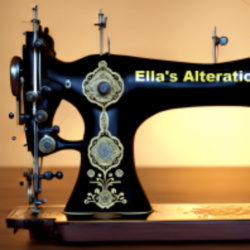

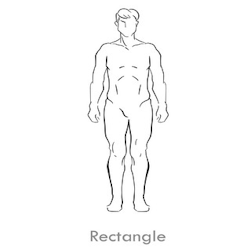 Understanding the Rectangular Body Shape for Men
Understanding the Rectangular Body Shape for Men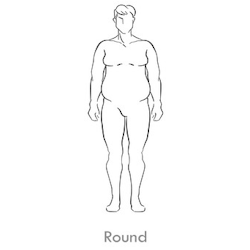 Understanding the Oval Body Type in Men: A Style Guide
Understanding the Oval Body Type in Men: A Style Guide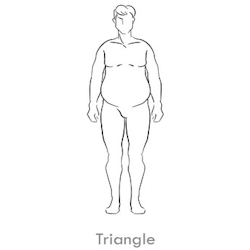 Understanding the Triangle Body Shape in Men: Style Guidelines and Tips
Understanding the Triangle Body Shape in Men: Style Guidelines and Tips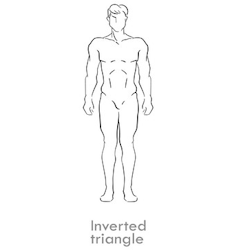 Understanding the Inverted Triangle Body Shape for Men
Understanding the Inverted Triangle Body Shape for Men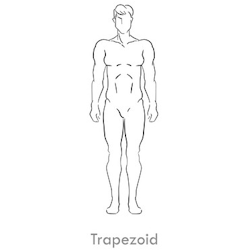 Understanding the Inverted Trapezoid Body Shape in Men
Understanding the Inverted Trapezoid Body Shape in Men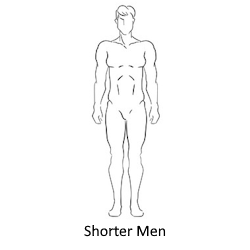
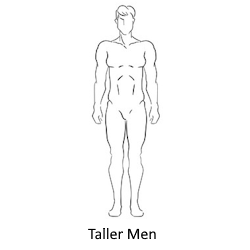
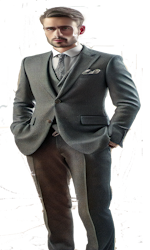 Italian Style
Italian Style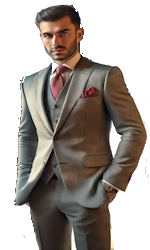 American Style
American Style
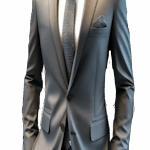 Pros:
Pros: Pros:
Pros: Pros:
Pros: